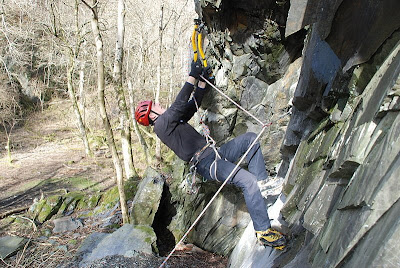After our holidays Ryan and I were keen on a climb which was longer and more memorable that the usual Norries affair. The reports said that ice was building and in the back of my mind I remembered that Scorpion was a 240 m V,5 ice route on Carn Etchachan that had a sting in the tail. Everything suggested that this is a classic: Tom Patey’s first winter route on Carn Etchachan (joined by J.M. Taylor, A.G. Nicol and K.A. Grassick in December 1952), it is in Cold Climbs and the ‘sting in the tail’ sentence sticks in the mind. It is maybe because of the sting of the tail that probably few people attempt it even although there are many climbers that can climb V,5 without much of a problem.
On the 3rd of January we left Aberdeen at 6 am, which is late for such a big route, but had a speedy walk in and arrived at 10.30 at the bottom of Carn Etchachan. The first picture shows Ryan when Carn Etchachan and the Shelterstone appeared.

It all looked relatively lean but the turf was well frozen and there was a reasonable snow cover after an overnight snowfall. Here is a topo based on a photo when Adam and I did Route Major two years ago as I didn't get a good photo of the route this time round (we were initially unsure about the line).

Tricky mixed climbing started almost immediately and we found that when there is little ice then there is a lot of hard mixed climbing including some tech 6 moves.

Another Aberdonian team (Mark Mosgrove and Kevin Neal) was on Red Guard. This photo shows one of them eaten by the large chimney.

After the first pitch the subterranean crack follows which requires Caingorms style full body contact climbing. It will be tricky in any condition.

Ryan hooking for glory...

... and happy after a good struggle!

The following short overhanging wall on good holds is pumpy but the hooks and turf are helpful. We were looking forward to easier climbing but a very hard slab followed which probably has ice in good condition. It involved tenuous, delicate climbing with not so good hooks and very poor footholds on the slab plus not really trustworthy gear. Pumped, searching for a good hook and not much left in the tank I only found a Steinpull at the top which allowed a good reach for a less than perfect placement on turf and after a delicate pull up the hardest bit was over. This bit was for both of us harder than anything on Deep Throat which is given V,6. There was now a stretch of easier climbing on good frozen turf.

After that we reached the Scorpion gully which led to the 'sting in the tail'.

The guidebook says it is ‘either a hard ice pitch in lean conditions, but more commonly it is a problematical cornice’. Today it was the ice pitch but the gear was good and although the ice was brittle there were good footholds on the right wall. It was not too bad but still deserved tech 5. Some more climbing on sometimes good and sometimes sugary neve remained to the cul de sac at the end of the gully. Some tat was hanging from the vertical left wall as a reminder of the entertainment that can be had if the cornice is big (the guidebook says an escape on the left can be pegged; bring 10 pegs if you fancy that) but tonight the Scorpion finally showed some mercy and offered a balancy traverse to the right. Exposed, wobbly tiptoeing on sugary neve in the fading light got me to the steep right hand neve slope and I was much relieved when I found a so so runner behind a flake. After some more shuffling I bridged over to a bit of neve that was less steep and reached a tower at the top. Ryan had to climb with his headtorch and managed as a last effort to do this pitch quickly.

It is the route of the season so far for both of us and we compared it to a heavy weight 12 round boxing fight. If there was no history and we had to give it a grade in relation to other climbs then it would deserve in our opinion a VI,6 in these conditions. The difficulty is tech6 when compared to Belhaven, Deep Throat, Savage Slit, Guillotine, Honeypot, Sticil face (i.e. the tech 6 routes we have done). Also a VI because it is long and the difficulties in the lower bit are sustained plus the sting can be hard at the end. Certainly altogether more than point five or Sticil face where the difficulties are relatively short.
But it is a classic V,5 Patey route and will be that in good conditions (climable neve and snow ice most of the time and the cornice is not too much of a monster). However a guidebook sentence such as ‘aspirants might find that the Scorpion bites more at the bottom but stings less at the top in lean conditions’ might be good to add.






































